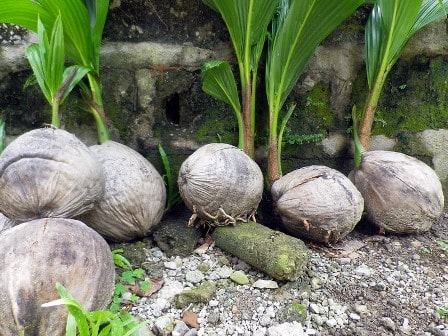The coconut tree is a member of the palm tree family and is mainly found in tropical and subtropical climates. They need warmth and moisture all over the year to grow appropriately.
The coconut tree provides us with food, cosmetics, and fuel and is used in making various materials used in furnishing or can be utilized for decoration purposes. According to botany, coconut is not a nut but a drupe.
A human being is the only species on this planet that completely uses this drupe. The inner flesh of the coconut and its milk is utilized in making food in different parts of the World.
The coconut is quite different from other fruits because its endosperm contains water, also called coconut water. People even drink this Coconut water to quench their thirst in different parts of the World.
So, how long does a coconut tree take to grow? Every coconut tree grows from a single seed and takes 5-8 years to fully mature and bear fruit. So, you need to have a lot of patience while plating a coconut tree. There are over 150 species of coconut trees in the World. So their time of bearing fruit differs from one species to another.
The article discusses step by step regarding the growth of a coconut tree. So, keep reading this article to learn more about coconut tree cultivation.
MORE POSTS: Philodendron Xanadu Propagation and Care

How Can You Grow A Coconut Tree?
Coconut trees produce fruits that are pretty tasty to eat. They no doubt grow best in tropical climates, but you can grow them at home.
Here is a step-by-step procedure to follow while growing coconut trees in your yard.
1. Choose The Coconut Fruit
You need the fruit of the coconut tree for propagation. You can use the coconut fruit fallen on the ground of your yard for germination purposes or buy it from the store and use it for propagation purposes. But remember, the ideal fruit for germination is the one that has a lot of water inside it and usually slosh at the time of shaking.
2. Place The Coconut Fruit In A Bucket Containing water
Now place the coconut in a bucket that contains lukewarm water and leave it for almost five days. This process helps in softening the coconut and enhances the process of germination.
3. Take A Ziplock Bag
Now remove the coconut from the bucket containing lukewarm water. Take a ziplock bag, fill it with one cup of water, place the coconut in the zip lock bag, and store it for almost three months.
4. Check Each Week
You need to check the coconut every week. If you find that it has started to sprout and roots are visible, take a damp paper towel and wrap the coconut. Place the nut back in the zip lock bag.
The seed is wholly developed when you observe the sprouts are about your finger size and the roots are 15-20 cm.
5. Start Planting
You need to choose a place with loose and drained soil and then place the coconut in the soil. You can add sand on the top of the soil so the water will drain properly. But remember always to put the pointed end down into the soil. You must water the plant at least two times a week. It will help in keeping the soil moist. The tree should get sufficient sunlight to grow.
6. Use Fertilizer
You need to add fertilizer to the soil after one year. Use a good fertilizer with nutrients like boron, potassium, magnesium, and others.
7. Harvest
The tree fully matures and produces fruit after 5 -8 years. You will first observe flowers in the Coconut tree. These flowers turn into fruits after nine months. The best time to harvest a coconut is 7.5 months after the flower starts blooming.
Coconuts usually drop and fall on the ground when they become fully mature. A single coconut tree usually gives 150 coconuts in a year. The coconut tree lives for almost 60 -100 years. The life cycle of a coconut tree is a bit lengthy but gives you a tasty fruit you can enjoy every year. The average weight of a coconut tree is usually 6 pounds.
MORE POSTS: How to Grow a Coconut Tree from a Store Bought Coconut
What Are The Different Tips You Need To Keep In Mind While Growing A Coconut Tree?
1. Remove The Affect Tree
Coconut trees can have diseases like lethal yellow, in which the leaves become yellowish. The fruit starts to drop, and it even kills the plant slowly.
Another disease in coconut trees is fungal bud rot, in which the leaves smell unpleasant or look grey. It mainly occurs because of heavy rain or if you have planted coconut trees in poor drainage soil.
It’s best to remove the affected tree if it has any disease or fungus has affected it badly.
2. Cold Weather Is Not Ideal For Growing Coconut Trees
If you are staying in cold weather region, then it’s not wise to grow coconut plants outside. Well, you can choose to grow a coconut tree in a pot. But remember that it can grow up to 5 feet and will not bear fruit. But yes, that can increase the aesthetic value of your dwelling.
3. Ideal Temperature
A coconut grows best in summer. The minimum temperature for growing a coconut tree is 22-degree Celsius. But very high temperatures can decrease the production of coconuts in a year. The growth of a coconut tree is disturbed if you plant it in a shade or cloudy area.
4. Rainfall
Rainfall within 1000 -3000mm is good enough for growing a coconut tree.
5. Humidity And Wind
Relative humidity of 80-85 percent is optimum for growing a coconut tree. But if the humidity increases, it increases pests and diseases in a coconut tree.
Simultaneously wind plays a significant factor in a tall coconut tree. High winds can affect pollination and flower fertilization. It can even enhance the transpiration rate, and roots start drawing more nutrients from the soil.
A coconut tree can tolerate high winds but not cyclones. A cyclone can even uproot a coconut tree.
6. Soil
A coconut tree can grow well in different soil types like alluvial, sandy, and laterite.
Conclusion
Coconut trees have ample benefits. But it takes almost 5-8 years to mature and produce fruit. So, you must patiently wait till the time the coconut tree bear fruit.
We have listed below the procedure for growing coconut trees, along with a few tips and tricks necessary for the plant’s proper growth. So, follow it and plant a coconut tree in your garden.
MORE POSTS: How long does it take rose cuttings to root in water?



